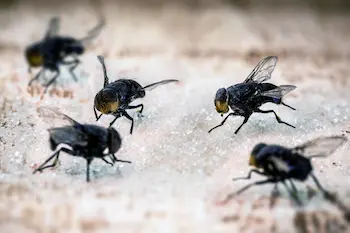
Commercial food and beverage facilities do their best to uphold clean environments everyday, but sometimes bird deterrent strategies aren’t even on their to-do list.
Pest birds like pigeons and sparrows can lead to business disruptions and property damage. If bird activity or nesting has become more frequent around your facility, reach out to Bug Out for information on professional commercial bird control, and future prevention.
Potential health risks
Birds may seem harmless to some, but in reality they can carry pathogens, fungal spores, and ectoparasites. These health concerns can be transmitted through their feathers, nests, or within their droppings. Birds have been linked to the spread of more than 60 diseases, including histoplasmosis, encephalitis, Salmonella, toxoplasmosis, and West Nile virus.
Potential company risks
Even a single bird or evidence of bird activity in a food processing facility can disrupt operations. If noticed during a health and regulatory inspection, one bird is all it takes to potentially cause a shutdown or plant closure. Additionally, during third-party audits, bird presence may strain business relationships, and companies could face significant fines for related violations.
Managing a bird issue isn’t as easy as applying a quick fix. Many species are protected under federal, state, and local laws, meaning actions like relocation, nest removal, or disrupting nests can carry legal and financial consequences. Consulting with experts before taking action helps ensure compliance with these regulations.
Birds to look out for
Different bird species can create challenges for food processing facilities, though some are encountered more frequently than others.
Smaller birds, in particular, can slip indoors with ease, including:
- English house sparrows
- Common European starlings
- Swallows
Larger birds typically stay outside, but their presence can still lead to damage on rooftops and building structures, including:
- Pigeons
- Seagulls
What makes a bird interested in a facility?
The environment around a food processing facility plays a significant role in bird activity. Locations near water, landfills, or feed mills often attract higher bird populations and may need enhanced control measures.
Within the facility, certain conditions and areas can make it more inviting to birds. Birds typically search for the following:
- Open dumpsters and spilled products outdoors, offering them an easy food source.
- Sheltered areas beneath overhangs that make prime nesting locations.
- Structural gaps, including those in corrugated siding, soffits, and weep holes, which provide additional nesting spots.
- Damaged dock door bumpers can collect food debris, drawing in birds looking for nesting sites.
- Windows and doors left open for ventilation or accessibility provide birds with direct entry.
- Any small openings around doors, which can be enough for birds to walk right in.
Causes of bird contamination
Birds contaminate food processing facilities by entering the building, or even gathering on rooftops.
Open doors provide an easy entry point, and some bird species quickly learn to exploit these opportunities, flying in when they know it’s possible. Once inside, they may fly through the facility or perch on rafters and other elevated surfaces, where droppings can land on production lines or stored goods, creating a multitude of contamination risks.
Rooftops also attract birds, as the high nesting point gives them an advantage for locating food and shelter. HVAC systems, mechanical equipment, and air circulation units generate warmth, and ultimately draw birds to these areas. As these systems run, they can pull in feathers and droppings, potentially circulating contaminants throughout the facility.
5 ways to prevent bird-associated risks
Preventing bird contamination is crucial for any food processing facility. Working with a bird control specialist can help you identify the most effective strategies, tailored to your facility’s specific layout and surroundings.
Until you have access to a professional, consider these steps:
1.Ensure doors and windows remain closed.
Birds frequently enter through doors left open for ventilation or convenience. Installing screen doors maintains airflow while keeping birds out, and strip doors offer a flexible barrier that allows movement while discouraging bird entry. Reinforcing the practice of closing doors and windows when not in use also helps prevent birds from gaining access.
2. Seek expert advice for bird exclusion solutions.
Installing netting under overhangs can keep birds from nesting or roosting in these sheltered spaces. This method also discourages birds from congregating near entryways, decreasing the likelihood of any sneaking inside.
3. Use perch deterrents in outdoor areas where birds frequently gather.
Devices such as spikes and electric tracks make surfaces less inviting without harming birds, encouraging them to roost elsewhere and minimizing their presence around the facility.
4. Seal gaps at dock doors while trucks are present and inspect the building for any small openings.
Even the smallest gaps can serve as entry points for birds, so it’s best to perform routine area checks around your facility. Observing deliveries and product pickups are common areas where birds may be gathering or slipping inside.
5. Educate staff on the importance of deterring birds.
Employees may not always be aware of the risks birds pose, so be sure to provide updated training on potential issues and preventive measures. Reinforcing quick cleanup standards, proper product storage, and waste management can help minimize the interest birds have. Assigning a team member to regularly inspect garbage and dumpster areas can further reduce available food sources and nesting materials.
Other bird control strategies, such as hazing techniques or vegetation management, may also be beneficial. The most effective approach will depend on the facility’s layout, the bird species present, and the surrounding environment.
Professional bird control for lasting solutions
Even one bird can cause unexpected disruptions, take action before a problem begins.
If bird activity has increased around your facility or you’ve had issues with them getting inside, contact the experts at Bug Out. Schedule a consultation at the first sign of a problem to keep your operations running smoothly.





